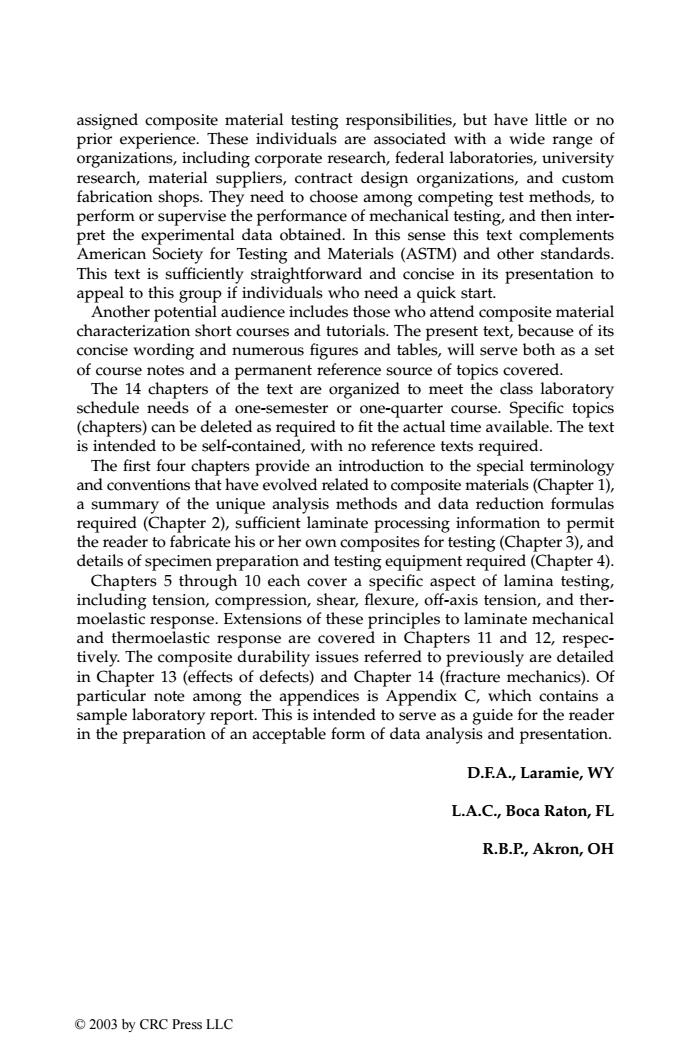正在加载图片...

assigned composite material testing responsibilities,but have little or no prior experience.These individuals are associated with a wide range of organizations,including corporate research,federal laboratories,university research,material suppliers,contract design organizations,and custom fabrication shops.They need to choose among competing test methods,to perform or supervise the performance of mechanical testing,and then inter- pret the experimental data obtained.In this sense this text complements American Society for Testing and Materials (ASTM)and other standards This text is sufficiently straightforward and concise in its presentation to appeal to this group if individuals who need a quick start. Another potential audience includes those who attend composite material characterization short courses and tutorials.The present text,because of its concise wording and numerous figures and tables,will serve both as a set of course notes and a permanent reference source of topics covered. The 14 chapters of the text are organized to meet the class laboratory schedule needs of a one-semester or one-quarter course.Specific topics (chapters)can be deleted as required to fit the actual time available.The text is intended to be self-contained,with no reference texts required. The first four chapters provide an introduction to the special terminology and conventions that have evolved related to composite materials(Chapter 1), a summary of the unique analysis methods and data reduction formulas required(Chapter 2),sufficient laminate processing information to permit the reader to fabricate his or her own composites for testing (Chapter 3),and details of specimen preparation and testing equipment required(Chapter 4). Chapters 5 through 10 each cover a specific aspect of lamina testing, including tension,compression,shear,flexure,off-axis tension,and ther- moelastic response.Extensions of these principles to laminate mechanical and thermoelastic response are covered in Chapters 11 and 12,respec- tively.The composite durability issues referred to previously are detailed in Chapter 13(effects of defects)and Chapter 14(fracture mechanics).Of particular note among the appendices is Appendix C,which contains a sample laboratory report.This is intended to serve as a guide for the reader in the preparation of an acceptable form of data analysis and presentation. D.F.A.,Laramie,WY L.A.C.,Boca Raton,FL R.B.P.,Akron,OH ©2003 by CRC Press LLCassigned composite material testing responsibilities, but have little or no prior experience. These individuals are associated with a wide range of organizations, including corporate research, federal laboratories, university research, material suppliers, contract design organizations, and custom fabrication shops. They need to choose among competing test methods, to perform or supervise the performance of mechanical testing, and then interpret the experimental data obtained. In this sense this text complements American Society for Testing and Materials (ASTM) and other standards. This text is sufficiently straightforward and concise in its presentation to appeal to this group if individuals who need a quick start. Another potential audience includes those who attend composite material characterization short courses and tutorials. The present text, because of its concise wording and numerous figures and tables, will serve both as a set of course notes and a permanent reference source of topics covered. The 14 chapters of the text are organized to meet the class laboratory schedule needs of a one-semester or one-quarter course. Specific topics (chapters) can be deleted as required to fit the actual time available. The text is intended to be self-contained, with no reference texts required. The first four chapters provide an introduction to the special terminology and conventions that have evolved related to composite materials (Chapter 1), a summary of the unique analysis methods and data reduction formulas required (Chapter 2), sufficient laminate processing information to permit the reader to fabricate his or her own composites for testing (Chapter 3), and details of specimen preparation and testing equipment required (Chapter 4). Chapters 5 through 10 each cover a specific aspect of lamina testing, including tension, compression, shear, flexure, off-axis tension, and thermoelastic response. Extensions of these principles to laminate mechanical and thermoelastic response are covered in Chapters 11 and 12, respectively. The composite durability issues referred to previously are detailed in Chapter 13 (effects of defects) and Chapter 14 (fracture mechanics). Of particular note among the appendices is Appendix C, which contains a sample laboratory report. This is intended to serve as a guide for the reader in the preparation of an acceptable form of data analysis and presentation. D.F.A., Laramie, WY L.A.C., Boca Raton, FL R.B.P., Akron, OH TX001_FM_Frame Page 8 Tuesday, September 24, 2002 11:20 AM © 2003 by CRC Press LLC